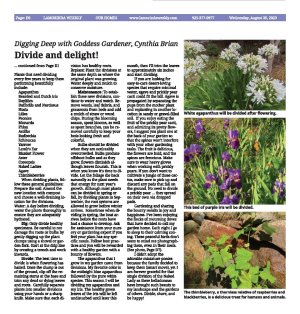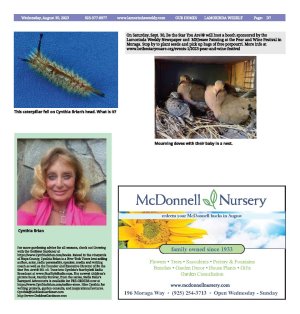|
|
Published August 30th, 2023
|
Digging Deep with Goddess Gardener, Cynthia Brian
|
| Divide and delight! |
| By Cynthia Brian |
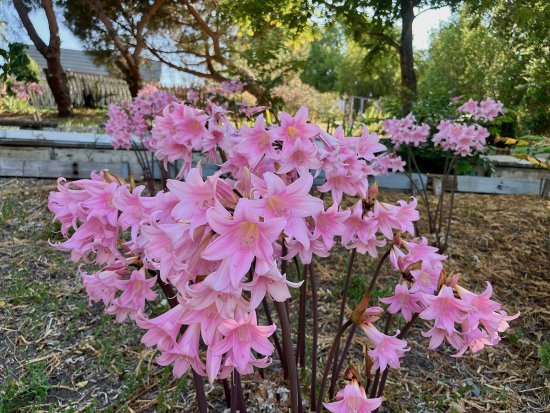 |
| A hillside of Naked Ladies. Photos Cynthia Brian |
"There are no happier folks than plant lovers, and none more generous than those who garden." ~ Ernest Wilson
 Many years ago, I was considering adopting two miniature ponies. When I visited the ranch where they were living there was a small pond surrounded by a flush of gorgeous pink blooms that I had never seen before. When I asked the property owner what they were, she told me they were Naked Ladies, a bulb that boasted bright green spear-like foliage in the winter. When the foliage died at the end of spring, it was necessary to remove the brown leaves, leaving the turtle- shaped bulbs slightly protruding from the ground.
Many years ago, I was considering adopting two miniature ponies. When I visited the ranch where they were living there was a small pond surrounded by a flush of gorgeous pink blooms that I had never seen before. When I asked the property owner what they were, she told me they were Naked Ladies, a bulb that boasted bright green spear-like foliage in the winter. When the foliage died at the end of spring, it was necessary to remove the brown leaves, leaving the turtle- shaped bulbs slightly protruding from the ground.
 Indicating that her Naked Ladies needed dividing, she dug up a bulb, instructing me to plant it in the sun "anywhere," irrespective of soil condition. "Wait for next summer's surprise," she said. I followed her directions, and that one bulb has evolved into many hundreds that blanket my hillside in a sea of pink perfection. Over the years I have divided, dug, and donated bulbs to many friends, offering them a summer surprise. Divide and delight! It makes me so happy!
Indicating that her Naked Ladies needed dividing, she dug up a bulb, instructing me to plant it in the sun "anywhere," irrespective of soil condition. "Wait for next summer's surprise," she said. I followed her directions, and that one bulb has evolved into many hundreds that blanket my hillside in a sea of pink perfection. Over the years I have divided, dug, and donated bulbs to many friends, offering them a summer surprise. Divide and delight! It makes me so happy!
 This time of year is a perfect time to divide a wide variety of bulbs and perennials. Besides increasing the number of plants in your garden, divisions can be donated to other gardeners. Dividing overcrowded plants will give the remaining plants room to grow, maintain their health, and rejuvenate your beds. Over-crowded and over-grown plants will not bloom profusely, however, not all perennials or bulbs benefit from dividing.
This time of year is a perfect time to divide a wide variety of bulbs and perennials. Besides increasing the number of plants in your garden, divisions can be donated to other gardeners. Dividing overcrowded plants will give the remaining plants room to grow, maintain their health, and rejuvenate your beds. Over-crowded and over-grown plants will not bloom profusely, however, not all perennials or bulbs benefit from dividing.
 Before you begin, water the area well a few days before digging. With a shovel or garden fork, dig a large area to remove a clump with the root ball, bulbs, or rhizomes intact. Once out of the ground, shake off the excess dirt and cut or pull apart individual crowns. For perennials, make sure you have roots and leaves. Bulbs and rhizomes need roots attached. To avoid having the roots dry out, plant immediately in another area at the same depth and water deeply. To conserve moisture, add mulch to these newly divided plants.
Before you begin, water the area well a few days before digging. With a shovel or garden fork, dig a large area to remove a clump with the root ball, bulbs, or rhizomes intact. Once out of the ground, shake off the excess dirt and cut or pull apart individual crowns. For perennials, make sure you have roots and leaves. Bulbs and rhizomes need roots attached. To avoid having the roots dry out, plant immediately in another area at the same depth and water deeply. To conserve moisture, add mulch to these newly divided plants.
 Not all plants want to be divided. It's best to leave Baptista, goatsbeard, lupine, milkweed, Russian sage, peony, red hot poker, bleeding heart, Hellebores, lavender, verbena, and oriental poppies alone. Plants that need dividing every few years to keep them performing beautifully include:
Not all plants want to be divided. It's best to leave Baptista, goatsbeard, lupine, milkweed, Russian sage, peony, red hot poker, bleeding heart, Hellebores, lavender, verbena, and oriental poppies alone. Plants that need dividing every few years to keep them performing beautifully include:
 Agapanthus
Agapanthus
 Bearded and Dutch iris
Bearded and Dutch iris
 Daylilies
Daylilies
 Daffodils and Narcissus
Daffodils and Narcissus
 Hosta
Hosta
 Lilies
Lilies
 Peonies
Peonies
 Monarda
Monarda
 Phlox
Phlox
 Astilbe
Astilbe
 Rudbeckia
Rudbeckia
 Echinacea
Echinacea
 Yarrow
Yarrow
 Lamb's Ear
Lamb's Ear
 Blanket Flower
Blanket Flower
 Aster
Aster
 Coreopsis
Coreopsis
 Naked Ladies
Naked Ladies
 Agave
Agave
 Thimbleberries
Thimbleberries
 When dividing plants, follow these general guidelines:
When dividing plants, follow these general guidelines:
 Prepare the soil: Amend the new location with compost and choose a well-draining location for the divisions.
Prepare the soil: Amend the new location with compost and choose a well-draining location for the divisions.
 Water: A day before dividing, water the plants thoroughly to ensure they are adequately hydrated.
Water: A day before dividing, water the plants thoroughly to ensure they are adequately hydrated.
 Dig: Only divide healthy specimens. Be careful to not damage the roots or bulbs by gently digging up the plant clumps using a shovel or garden fork. Start at the drip line by creating a trench and work inwards.
Dig: Only divide healthy specimens. Be careful to not damage the roots or bulbs by gently digging up the plant clumps using a shovel or garden fork. Start at the drip line by creating a trench and work inwards.
 Divide: The best time to divide is when flowering has halted. Once the clump is out of the ground, clip off the remaining stems at the base and trim any dead or dying leaves and roots. Carefully separate plants into smaller divisions using your hands or a sharp knife. Make sure that each division has healthy roots.
Divide: The best time to divide is when flowering has halted. Once the clump is out of the ground, clip off the remaining stems at the base and trim any dead or dying leaves and roots. Carefully separate plants into smaller divisions using your hands or a sharp knife. Make sure that each division has healthy roots.
 Replant: Plant the divisions at the same depth as where the original plant was growing. Water deeply and mulch to conserve moisture.
Replant: Plant the divisions at the same depth as where the original plant was growing. Water deeply and mulch to conserve moisture.
 Maintenance: To establish these new divisions, continue to water and
watch. Remove weeds, leaf debris, and grassroots from beds and add a
mulch of straw or wood chips. During the blooming season, spent
blooms, as well as spent branches, can be removed carefully to keep
your beds looking fresh and colorful.
Maintenance: To establish these new divisions, continue to water and
watch. Remove weeds, leaf debris, and grassroots from beds and add a
mulch of straw or wood chips. During the blooming season, spent
blooms, as well as spent branches, can be removed carefully to keep
your beds looking fresh and colorful.
 Bulbs should be divided when they are noticeably overcrowded. Bulbs produce offshoot bulbs and as they grow, flowers diminish although leaves flourish. This is when you know it's time to divide. Let the foliage die back naturally as the plant needs that energy for next year's growth. Although most plants can be divided in spring or fall, by dividing plants in September, the root systems are allowed to grow before winter arrives. Sometimes when dividing in spring, the heat arrives before the roots have had a chance to develop. Ask for assistance from your nursery or gardening expert if you feel your plant has any specific needs. Follow best practices and you will be rewarded with a healthy garden with a bounty of flowers.
Bulbs should be divided when they are noticeably overcrowded. Bulbs produce offshoot bulbs and as they grow, flowers diminish although leaves flourish. This is when you know it's time to divide. Let the foliage die back naturally as the plant needs that energy for next year's growth. Although most plants can be divided in spring or fall, by dividing plants in September, the root systems are allowed to grow before winter arrives. Sometimes when dividing in spring, the heat arrives before the roots have had a chance to develop. Ask for assistance from your nursery or gardening expert if you feel your plant has any specific needs. Follow best practices and you will be rewarded with a healthy garden with a bounty of flowers.
 The agapanthus that I grow in my garden came from divisions. My favorite color is the midnight blue agapanthus followed by the pure white species. This season I will be dividing my agapanthus and my iris. The healthy green leaves of the iris will be left undisturbed until later this month, then I'll trim the leaves to approximately six inches and start dividing.
The agapanthus that I grow in my garden came from divisions. My favorite color is the midnight blue agapanthus followed by the pure white species. This season I will be dividing my agapanthus and my iris. The healthy green leaves of the iris will be left undisturbed until later this month, then I'll trim the leaves to approximately six inches and start dividing.
 If you are looking for easy-to-care desert-loving species that require minimal water, agave and prickly pear cacti could fit the bill. Agave is propagated by separating the pups from the mother plant and replanting in another location in sandy or gravel-filled soil. If you enjoy eating the fruit of the prickly pear cacti, and admiring its pretty flowers, I suggest you plant one at the back of your garden so that the spines won't interfere with your other gardening tasks. The fruit is delicious, the flowers are bold, and the spines are ferocious. Make sure to wear heavy gloves when working with prickly pears. If you don't want to cultivate a jungle of these cactus, make sure to pick up and discard any pads that fall on the ground. No need to divide a prickly pear . they spread on their own via dropped pads.
If you are looking for easy-to-care desert-loving species that require minimal water, agave and prickly pear cacti could fit the bill. Agave is propagated by separating the pups from the mother plant and replanting in another location in sandy or gravel-filled soil. If you enjoy eating the fruit of the prickly pear cacti, and admiring its pretty flowers, I suggest you plant one at the back of your garden so that the spines won't interfere with your other gardening tasks. The fruit is delicious, the flowers are bold, and the spines are ferocious. Make sure to wear heavy gloves when working with prickly pears. If you don't want to cultivate a jungle of these cactus, make sure to pick up and discard any pads that fall on the ground. No need to divide a prickly pear . they spread on their own via dropped pads.
 Gardening and sharing the bounty results in joy and happiness. I've been enjoying the flocks of mourning doves that have decided to call my garden home. Each night I go to sleep to their calming cooing. These peaceful birds don't seem to mind me photographing them, even in their nests. (See photo
below).
Gardening and sharing the bounty results in joy and happiness. I've been enjoying the flocks of mourning doves that have decided to call my garden home. Each night I go to sleep to their calming cooing. These peaceful birds don't seem to mind me photographing them, even in their nests. (See photo
below).
 I didn't adopt the adorable miniature ponies because the family decided to keep them (smart move), yet I am forever grateful for that single division of the Naked Lady as these belladonnas have brought such beauty to my landscape and the gardens of others. Divide, share, and be happy!
I didn't adopt the adorable miniature ponies because the family decided to keep them (smart move), yet I am forever grateful for that single division of the Naked Lady as these belladonnas have brought such beauty to my landscape and the gardens of others. Divide, share, and be happy!
 On Saturday, Sept. 30, Be the Star You Are!r will host a booth sponsored by the Lamorinda Weekly Newspaper and MBJessee Painting at the Pear and Wine Festival in Moraga. Stop by to plant seeds and pick up bags of free potpourri. More info at
www.bethestaryouare.org/events-1/2023-pear-and-wine-festival
On Saturday, Sept. 30, Be the Star You Are!r will host a booth sponsored by the Lamorinda Weekly Newspaper and MBJessee Painting at the Pear and Wine Festival in Moraga. Stop by to plant seeds and pick up bags of free potpourri. More info at
www.bethestaryouare.org/events-1/2023-pear-and-wine-festival |
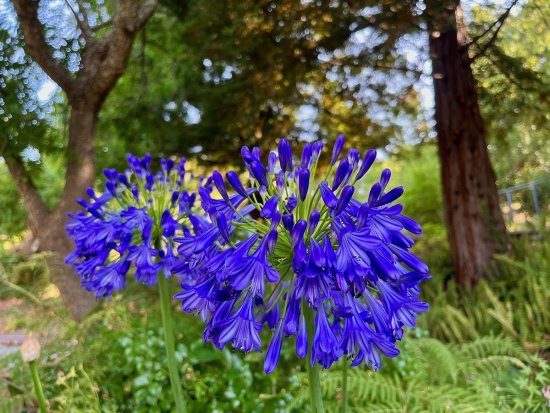 |
| Midnight blue agapanthus. Photos Cynthia Brian |
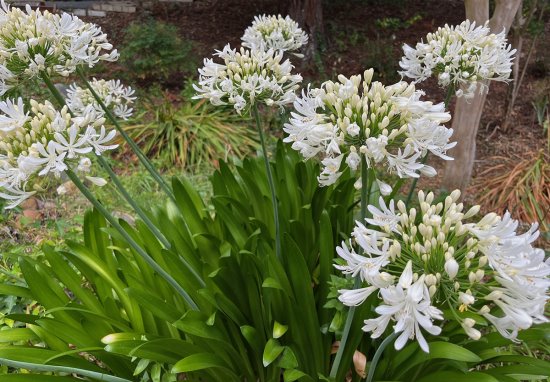 |
| White agapanthus will be divided after flowering. Photos Cynthia Brian |
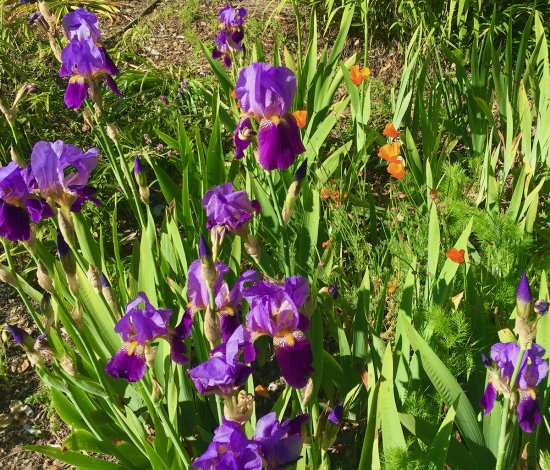 |
| This bed of purple iris will be divided. Photos Cynthia Brian |
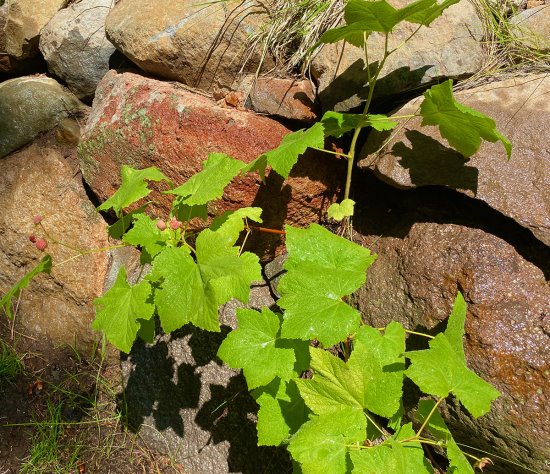 |
| The thimbleberry, a thornless relative of raspberries and blackberries, is a delicious treat for humans and animals. Photos Cynthia Brian |
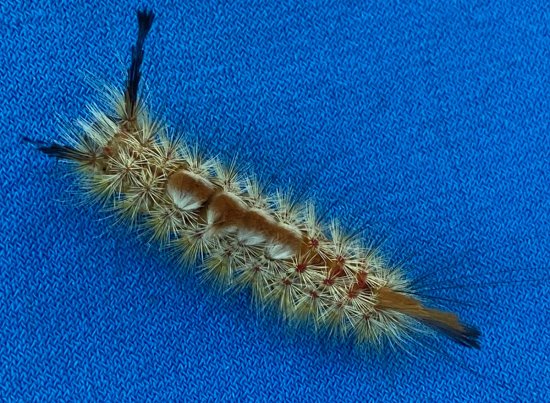 |
| This caterpillar fell on Cynthia Brian's head. What is it? |
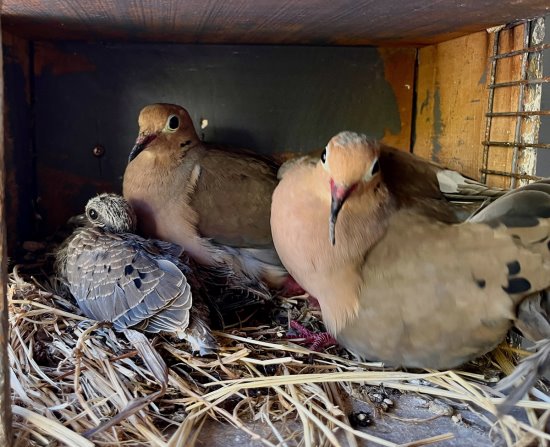 |
| Mourning doves with their baby in a nest. |
 |
| For more gardening advice for all seasons, check out Growing with the Goddess Gardener at
https://www.CynthiaBrian.com/books. Raised in the vineyards of Napa County, Cynthia Brian is a New York Times best-selling author, actor, radio personality, speaker, media and writing coach as well as the Founder and Executive Director of Be the Star You Are!r 501 c3. Tune into Cynthia's StarStyler Radio Broadcast at
www.StarStyleRadio.com. Her newest children's picture book, Family Forever, from the series, Stella Bella's Barnyard Adventures is available for PRE-ORDERS now at
https://www.CynthiaBrian.com/online-store. Hire Cynthia for writing projects, garden consults, and inspirational lectures.
Cynthia@GoddessGardener.com
http://www.GoddessGardener.com |
|
|
|











